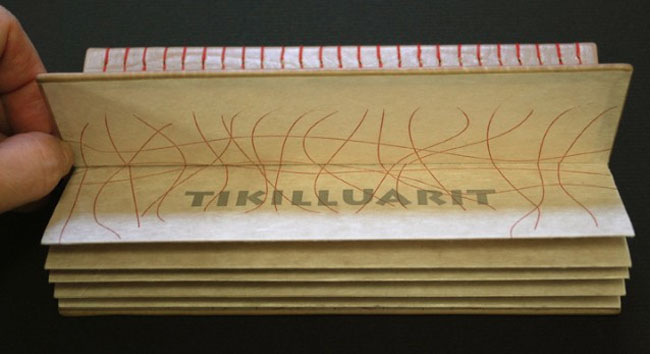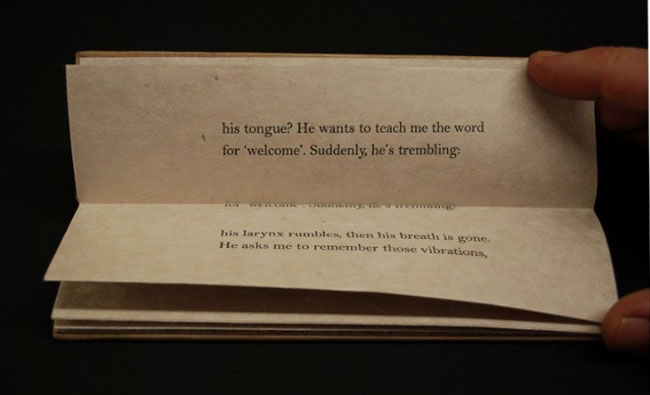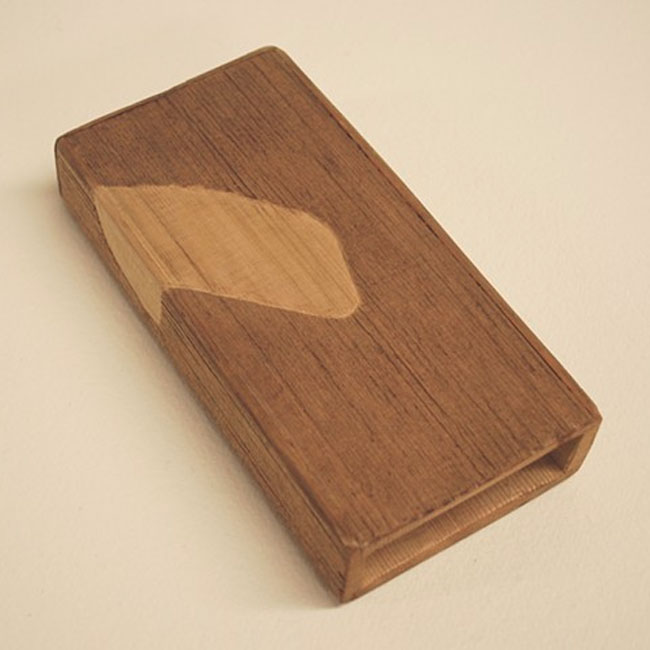Tikilluarit was created for the An Inventory of Al-Mutanabbi Street exhibition, which began in 2012, exhibiting nationally and internationally until 2015. The exhibition showcases a collection of artist books and broadsides that are a response to the explosion of a car bomb in Al-Mutanabbi Street, the historic center of bookselling and arts culture in Baghdad, back in March 2007. The exhibit came to Cambridge and was exhibited in three parts. Unfortunately, the session I attended did not included this particular work (I wrote a post about it).
Tikilluarit is the collaborative work of three artists. But Roni Gross is the star of this post; her concept transformed a written piece into a conceptual binding. The sonnet, which makes up the text of the book, was recast from a Greenlandic series by Nancy Campbell titled “The Hunter Teaches Me To Speak” (originally published in Modern Poetry in Translation). The word ‘tikilluarit’ means ‘welcome’ in Kalaallisut, the native language in Greenland. The sonnet is as follows:
The hunter teaches me to speak
I place my fingers round his neck and feel
his gorge rise – or is he swallowing
his tongue? He wants to teach me the word
for ‘welcome’. Suddenly, he’s trembling:
his larynx rumbles, then his breath is gone.
He asks me to remember those vibrations,
and, anxious as a nurse who takes a pulse,
touches my throat to judge its contortions.
Will I ever learn these soft uvulars?
I’m so eager, I forget that the stress
always falls on the second syllable.
My echo of his welcome is grotesque.
He laughs, an exorcism of guillemets,
dark flocks of sound I’ll never net, or say.
The modified accordion binding was executed by Biruta Auna using calfskin while Roni designed and letterpress printed the text on Mitsumata paper.
Tikilluarit is bound in such a way that offers little access to the interior parts of the book. How does the text and binding correlate to one another?
The poem speaks about a person trying to mimic the sound of a word spoken by another person by placing a hand around the throat of the speaker. The spine side of the book was made to be as visually important as the text block, which serves in effect, as the throat of the book. The text moves up and into the spine as if going down the throat. The exposed sewing is similar to the anatomy of the vocal cords.
The fourth collaborator is Peter Schell who crafted the unique sound sculpture that is paired with the deluxe edition of the book. In addition the deluxe edition includes a waxed linen wrap to house both the book and sound sculpture.
Paired with the book is a wooden sound sculpture that can be activated by shaking it. What does the element of sound bring to the experience of this piece?
The speaker in the poem says of the difficulty in learning to the language…”dark sounds that I will never net or say”. The wooden sculpture has an abstract wing pattern on the outside, which refers to an arctic bird which make a tinkling sound as its wings beat across the water. A sound that the human voice would not be able to replicate. It is another way of amplifying the words so that you can experience the poem in a physical way.
– – – – – – – – – – – – – –
I went into this interview not knowing very much about Roni, her history, her work or her artistic outlook. Through the interview, I hope you come to realize what I have: that Roni has a great appreciation for her artistic community and brings together unique artists in collaboration to expand on the concept of the book by conjuring up the senses. Enjoy the interview after the jump and sign up to receive email notifications so you don’t miss a post throughout the month of May which will feature more of Roni’s work.




